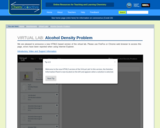
Determine the concentration of an alcohol solution from its density.
- Subject:
- Chemistry
- Physical Science
- Material Type:
- Activity/Lab
- Provider:
- Carnegie Mellon University
- Provider Set:
- The ChemCollective
- Date Added:
- 02/05/2021

Determine the concentration of an alcohol solution from its density.

Two lessons and their associated activities explore cellular respiration and population growth in yeasts. Yeast cells are readily obtained and behave predictably, so they are very appropriate to use in middle school classrooms. In the first lesson, students are introduced to yeast respiration through its role in the production of bread and alcoholic beverages. A discussion of the effects of alcohol on the human body is used both as an attention-getting device, and as a means to convey important information at an impressionable age. In the associated activity, students set up a simple way to indirectly observe and quantify the amount of respiration occurring in yeast-molasses cultures. Based on questions that arise from this activity, in the second lesson students work in small groups as they design and execute their own experiments to determine how environmental factors affect yeast population growth.

To increase students' awareness of possible invisible pollutants in drinking water sources, students perform an exciting lab requiring them to think about how solutions and mixtures exist even in unsuspecting places such as ink. They use alcohol and chromatography paper to separate the components of black and colored marker ink. Students witness first-hand how components of a solution can be separated, even when those individual components are not visible in solution.

This class examines the relationship between a number of mind-altering substances and cultural processes. We look at the relationship between drugs and such phenomena as poverty, religion, technology, inter-generational conflict, colonialism, and global capitalism. We read about the physiological and psychological effects of these substances -- ranging from alcohol to LSD, cocaine and ecstasy -- and ask why different societies prohibit and sanction different drugs. We examine the use of mind-altering substances in a number of "traditional" societies, and follow the development of a global trade in such substances as sugar, coffee, tea, nicotine, cocaine, and marijuana concurrent with the evolution of global capitalism. We look at the use of LSD as a mind-control substance by the CIA and as a mind-altering substance in the 1960's counter-culture, and we look at the rise of Prozac® and Viagra® as popular, if controversial, pharmaceutical products in recent years. Finally, we evaluate America's current drug laws.
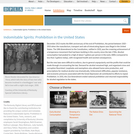
December 2013 marks the 80th anniversary of the end of Prohibition, the period between 1920 1933 when the manufacture, transport and sale of intoxicating liquors was illegal in the United States. The 18th Amendment to the Constitution, ratified in 1919, was the crowning achievement of a temperance movement that had been building in this country since the late 1700s. Alcohol consumption had peaked to a high of about 7 gallons per person in the early 1800s (compared to less than 3 gallons today), with recognized health and societal consequences. But the new laws were difficult to enforce, due to general unpopularity and the profits that could be made through circumventing the law. Demand for alcohol remained high, and organized crime and corruption flourished. Loopholes and exemptions also allowed home wine production, and prescriptions for medical alcohol rose dramatically. Enforcement difficulties, popular resistance, and economic pressures associated with the Great Depression all contributed to efforts to repeal Prohibition. In 1933, the 21st Amendment ended national prohibition and returned responsibility for alcohol regulation to the states. The Kentucky Digital Library and DPLA would like to thank the contributing institutions for providing the unique content and metadata featured in Indomitable Spirits: Prohibition in the United States. Texts, research, and compilation by University of Kentucky Libraries employees Sarah Dorpinghaus, Beth Kraemer, Kathryn Lybarger, Mary Molinaro, Judy Sackett, and Stacy Yelton. Repository and curation support provided by Tom Blake, Kate Boyd, Crystal Heis, Shelia McAlister, Sandra McIntyre, Danielle Pucci, Jason Roy, and Christopher Vinson.
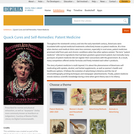
Throughout the nineteenth century and into the early twentieth century, Americans were inundated with myriad medicinal treatments collectively known as patent medicine. At a time when doctors and medical clinics were less common, especially in rural areas, patent medicines promised relief from pain and chronic conditions when few other options existed. The term patent medicine referred to ingredients that had been granted a government patent; but ironically many purveyors of patent medicine did not register their concoctions with the government. As a result, many competitors offered similar formulas and freely imitated each others products. The story of patent medicine is multi-layered. It is about the phenomenon of Americans self-medicating with opiates, alcohol, and herbal supplements, as well as womens health and healthcare options. It follows the evolution of advertising in America and the rise of chromolithography printing techniques and newspaper advertisements. Finally, patent medicine reveals dubious scientific knowledge during a time when germ theory was in its infancy. This exhibition was created as part of the DPLAs Public Library Partnerships Project by collaborators from Minnesota Digital Library. Exhibition organized by Greta Bahnemann.
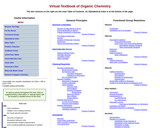
This virtual textbook allows for visualization of 3D-molecular models while teaching principles of Organic Chemistry. Before his retirement in 1999, Professor William Reusch began working on a virtual organic chemistry textbook that could be used by anyone with an interest in the subject. On this site, visitors can take advantage of his labors, and the introduction to this important subject offered on the homepage is a great place to start. After entering the main area of the site, visitors will find two columns of links that serve as the main table of contents. There are over twenty five topics covered here, and they include aromaticity, alkyl halides, alcohols, and amines. Each area contains lucid text accompanied by well-organized diagrams. Additionally, the site contains practice problems, incorporated into the text, along with links to external institutions such as the University of Wisconsin that offer additional problems. One area that shouldn't be missed is the "Chemicals and Society" area. Here visitors will find a narrative essay that addresses how the incorporation of different chemicals into air, water, and soil may affect human society over time.

This resource is a video abstract of a research paper created by Research Square on behalf of its authors. It provides a synopsis that's easy to understand, and can be used to introduce the topics it covers to students, researchers, and the general public. The video's transcript is also provided in full, with a portion provided below for preview:
"Meat is one of the most carbon-heavy foods we eat. Per gram of protein, producing beef, for example, requires 20 times the land and emits 20 times the emissions as growing beans. So steering away from meat is actually a great way to fight climate change, as it vastly shrinks our carbon footprint on the planet. But do households with small carbon footprints necessarily eat less meat than those with large footprints? A new study says no. The researchers behind the study recently examined data pertaining to diet and carbon footprint across 60,000 households in Japan, whose current diet and demographics, scientists believe, could set the trend for the rest of the world. Correlating food-spending patterns with the carbon intensity needed to produce different foods revealed that meat consumption was unrelated to the size of a household’s carbon footprint. Households with small, medium, or large footprints ate nearly identical amounts of meat..."
The rest of the transcript, along with a link to the research itself, is available on the resource itself.
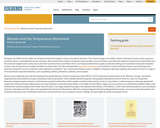
During the late 1800s and early 1900s, the Temperance Movement fought to reduce consumption of alcohol. The movement began in the 1820s, rooted in Protestant churches, led by clergy and prominent laymen, and powered by women volunteers. More women were involved in temperance than any other cause in US history up to that point. Women’s involvement seemed natural since the movement targeted men’s alcohol abuse and how it harmed women and children. At first, the Temperance Movement sought to moderate drinking, then to promote resisting the temptation to drink. Later, the goal became outright prohibition of alcohol sales. This shift coincided with a large wave of immigrants from Southern, Central, and Eastern Europe, and some temperance advocates echoed the concerns of nativists as they objected to immigrants’ “wet” cultures and drinking customs. In addition, temperance advocates regarded urban saloons as hosts to a range of immoral behaviors beyond drunkenness, such as gambling, adultery, prostitution, profanity, and corruption.